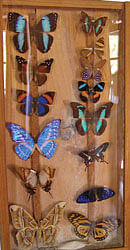
F redy’s Place, June Estate, Bhimtal, Uttarakhand. This address answers to a beautiful wooden house nestled amidst pine and deodar trees on a hill overlooking the picturesque Bhimtal town, a short distance away from Nainital. In this house lives Frederick Smetacek, Jr., bedridd

en since last 11 years after a reputed hospital in New Delhi allegedly went wrong while attempting to treat some serious injuries he had suffered during a fall at home.
But there was a time when Smetacek Jr would prance around the Himalayas, with a net in hand, and with the mission of collecting butterfly specimens. The result is all there to see at his abode, which, with its over 11,000 samples of butterflies and insects, arguably is the largest privately-run butterfly and insect museum in the whole of Asia, and quite surely, one of the largest in the world.
Hobby of collecting
As a young boy, Smetacek Jr was inspired by his father, Fredrick Smetacek’s small collection of butterflies, launching him into the hobby of collecting the flying beauties, mainly at the Raj Bhavan campus in Nainital where he was studying at the St Joseph School in Nainital.
For ten years from 1962, it was almost a daily routine for Smetacek Jr to scour the mountains in search of elusive species of butterflies, taking him as high as up to the Pindari Glacier where he captured the rare Snow Apollo. Before he stopped capturing butterflies when catching butterflies was made a legal offence, he collected the 11,000-plus comprising nearly 2,400 species that are on display in a room in his house. Smetacek Jr had started his hobby inspired by his father, who used to collect almost everything – postage stamps, matchbox covers, currency, and what not, apart from, course, butterflies and insects – but as he studied the world of butterflies and insects closely, his passion grew even more, because, as he says, “Butterflies and insects are the first indicators of any change in ecology.” Reclining on his bed, and surrounded by innumerable books, and the prized possessions of the rare VA Moth, captured in 1974 and said to be one of the only three in collection worldwide, and the Snow Apollo, both framed, he explains, “When I witnessed the wanton destruction of the mountains and its forests that started in the second half of the last century, it became my mission to collect as many specimens of these beautiful lives for posterity, because once they vanish, they never come back.
Of course, my collections went on till it was legal to catch butterflies.” Smetacek Jr also formed the Society of Appeal for Vanishing Environment, affiliated to the Eco-Ethics International of Germany, to create awareness about the destruction of the mountains by builders and loggers.
About two kms up a hill on the left bank of the Bhimtal lake, Fredy’s Place is located amidst beautiful surroundings, and a mountain track next to it is used by the locals to reach the Sattal lake that by road is at least ten km away. Visitors to the museum are mostly those who stay at a nearby resort or those who have heard about it, but there is no sign to mark the way to it or to attract visitors who are not aware about its existence. There have been reports that the government would take it over so that it could be maintained in the future too, but Smetacek himself does not seem too sure about whether that would be a good move. While his health conditions make it difficult for him to take care of the collection himself, though his assistant Prakash Kanaujia is doing the job to the best of his capabilities.
Talking to the 1951-born Smetacek Jr itself is a tour of knowledge about the Himalayas, particularly how the hills have been plundered by the unscrupulous and greedy land developers over the years. His German-speaking Czech-origin father, who had travelled on horseback from the Kathgodam at the foothills to buy the land at June Estate after earning a reasonable fortune supplying goods to the Allied Forces during the First World War in Kolkata, had fled Germany after an abortive attempt to assassinate Hitler, says the son. Once in India, the senior Smetacek integrated himself fully with the country, even marrying an Oriya girl. Now Smetacek Jr’s family members are scattered all over – his wife works with a telecom major in Delhi, his son is in Mumbai and his daughter in Canada, while two of his brothers are in Germany and the other two in Uttarakhand itself.
Local specimens
The museum has some unbelievably beautiful collection of butterflies, moths, beetles, spiders and other insects. Particularly awe-inspiring are his small but breathtaking collection of butterflies from other continents, while the local specimens include a whole range of oak butterflies that have wings perfectly mimicking oak leaves, helping to camouflage themselves.
Then there are the rare specimens like owl butterfly, peacock butterfly and snake butterfly. The range of the collection in size, colour and variety is simply amazing to say the least. “All this took years to collect. I caught the VA moth at 3 a.m. one night in 1974, and the Snow Apollo high up in the Himalayas after a long try,” reminisces Smetacek Jr. One can only hope that the man behind all this would be given proper assistance by the authorities to maintain the priceless collection in the best of environment. Or else, like many of the specimen themselves, the collection also could face the danger of extinction after the lifetime of the collector.